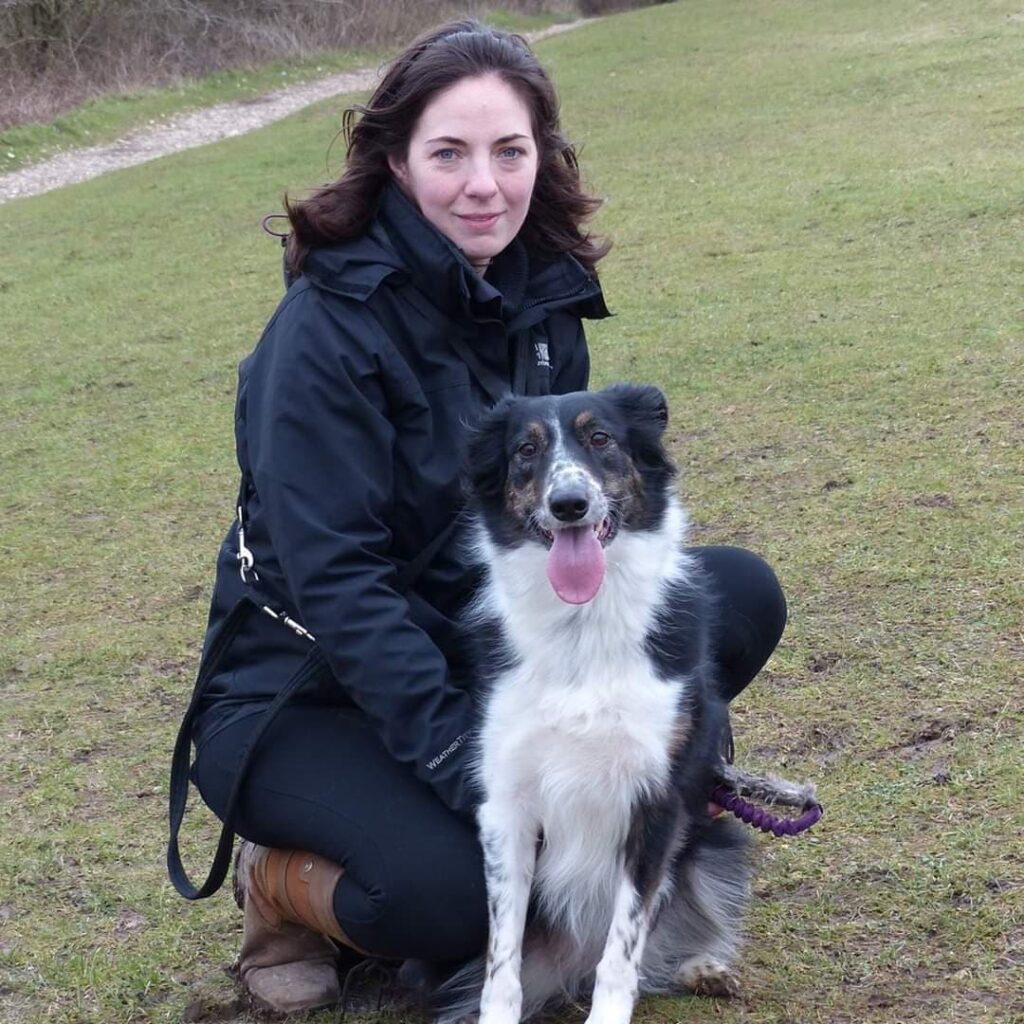
Dogs and their roles in helping humans
We are all familiar with seeing Guide Dogs supporting their humans but assistance dogs come in many forms. It is well recognised that assistance dogs and dogs in therapy can provide humans with greater independence, self-esteem, confidence and safety but it may be something that most of us know very little about.
To find out more, I posed a few questions to Claire
Can you describe the varying roles or areas that dogs may be involved in with regards to assisting humans?
The domestication of dogs has led to selective breeding and training dogs to assist humans in a variety of roles. Dogs initially supported humans with a variety of hunting and guarding based activities, as well as providing companionship. Now we rely on dogs to support us with a huge range of things:
- Detecting bombs, drugs, human cadavers, guns, viruses, cancer, and a range of health conditions.
- Tracking and searching for people and dogs as well as tracking wild animals for conservation purposes.
- Physical support, health support, emotional support and learning support.
There is great demand from the general population for assistance dogs and therapy dogs as people try to find ways to help themselves, their family, or their clients. Assistance dog charities are inundated with applications from people looking to have their own dogs to help them with tasks with a view to seeing an increase in their independence, self-esteem, and overall wellbeing. In the UK, according to Assistance Dogs UK, assistance dogs need to meet specific criteria to be deemed as supporting their client and this includes being trained to carry out tasks, not just for emotional support:
- alerting their guardians to changes in odour associated with their medical condition.
- alerting to sounds such as: alarm clocks, smoke alarms and doorbells.
- guiding their guardians around obstacles and stopping at curb sides to prevent their client from walking into a road.
- retrieving dropped items, emptying and filling things like a washing machine, helping to undress their clients and opening doors and drawers.
- providing pressure using their weight, to help with anxiety.
- retrieving medical bags when the guardian’s alarm goes off to remind them to tend to their health needs.
- and many more tasks!
https://www.assistancedogs.org.uk/
As well as assistance dogs who support one person or family, many people are looking for the emotional and physical help a dog can bring in community settings. Animal assisted intervention is the term used to cover the huge range of ways that animals can help:
- Animal Assisted Activity
- Animal Assisted Therapy (including Animal Assisted Play Therapy)
- Animal Assisted Education
https://risevanfleet.com/international/
With the increase in research surrounding how beneficial dogs can be in supporting people with a wide range of needs, more and more people are seeking the help of dogs or providing help with dogs.
So there is an obvious and huge benefit to the humans?
Many studies around animal assisted intervention and assistance dogs focus on the benefit to humans. There are very few studies looking into the wellbeing of the dogs in these situations. With easy access to articles and small studies relating to the wellbeing of people who have dogs, the challenges of dog guardianship are not always considered when researching dogs as support animals. This can lead to a lack of wellbeing for the dogs, behaviour that is challenging because of high expectations, and then as a result, relinquishment to rescue centres and breeders.
Within animal assisted intervention, Lincoln University have been researching the benefits of dogs to children and within this have produced a LEAD risk assessment tool due to a lack of best practice standards in animal assisted intervention in general: https://lead.blogs.lincoln.ac.uk/
Their risk assessment is a general document that can be used as a template for people looking to work with dogs in community settings such as schools, but I believe there are more wellbeing considerations that could be added for dogs. Animal assisted intervention is vastly different to assistance dogs as the dog could be interacting with a range of clients on a one to one or group basis over a period. They may be visiting various locations throughout their lives and interacting with huge numbers of people too. With this in mind, we need to be taking a close look at the suitability of dogs, their individual needs and regular assessments to determine whether they should be in their role.
There is little research into the cortisol levels of dogs working in animal assisted intervention or as assistance dogs. As Winkle.M, Johnson.A, and Mills.D state, the considerations for animal wellbeing, particularly in animal assisted intervention is not specific: https://doi.org/10.3390/ani10112188
This can and does lead to dogs ‘working’ in environments that are beneficial to the humans but not enjoyable and beneficial to the dogs. We all have a responsibility to ensure that dogs are enjoying their ‘work’ or we are putting our dogs and clients overall wellbeing at risk.
Can any dog be involved in supporting people? Are some breeds better than others or more suited to the roles?
Specific organisations providing working dogs, assistance dogs and dogs for animal assisted intervention tend to have their own preferences of breeds to train for the variety of roles. Genetics appear to play a strong part in the suitability of a dog for the role that they have been chosen for, but the training process can also play a large part in their success. Sometimes these preferences come down to the selection and training process that dogs go through overall so it can be difficult to say that a particular breed is more suited than others.
Dogs who are chosen to support people in animal assisted intervention tend to be chosen based on the individual preferences of the therapist or dog handler. Both methods of selection have their benefits and their challenges but overall, the important things to consider when choosing a dog are their individual capabilities and needs, specific to the role that may be asked of them.
Technically, the dogs are working dogs? We all need to have times when we are not actively working, how can that be managed or achieved?
As dogs do not follow the same sleep pattern as we do, it is important to ensure that clients receiving assistance dogs, and those working in animal assisted intervention, get to know their individual dog’s ideal routine and provide lots of time off for them.
On average, we understand that dogs sleep around 12 – 18 hours a day but much of this will be taken in short periods while still being restorative to the dogs. Assistance dogs and dogs in animal assisted intervention are usually raised in a way that teaches them how to get good quality, short sleep cycles in throughout their guardian’s more active periods and longer sleep cycles when they are more sedentary. Dogs are encouraged to learn how to settle on their own so that they are not continuously alert to their client’s needs and clients are taught how and when to give their dogs plenty of breaks from ‘working’.
Dogs needs days off from visiting public access areas and supporting their clients, and they also need to find their ‘work’ reinforcing. If a dog’s ‘work’ is a redirected version of using their natural instincts, is paired with reinforcers for that specific dog, and the dog has a choice over whether to do it or not, then I believe that we are helping to ensure our ‘working’ dogs needs and wellbeing are being met.
https://www.sciencedirect.com/science/article/pii/S2352154619301378
Are there any negative impacts for the dogs when in a supporting role?
Wellbeing of dogs in these roles should be paramount and lots of thought taken into the physical, emotional, and mental wellbeing of everything that they are being asked to do. Each dog is an individual and the level of work, or type of work that one dog may offer is likely to be different to another dog, so this should be considered.
If we do not advocate for the dog and ensure that we are not putting dogs into situations that are unsuitable then we will end up with repercussions:
- Emotional trauma
- Challenging behaviour
- Grieving
- Sensory overload
- Physical ailments
- And more
There are so many things that can be done to ensure that each individual ‘working’ dogs’ wellbeing is at the forefront of a trainer or therapists mind. It is important that we look at ‘standards of practice’ in the field and work together to ensure that these are well publicised, encouraged and adhered to.
Thank you, Claire, it’s clear from all that you have said that we really must take each dog, their strengths and weakness into account but also whether they can adjust to a supportive role or not. The welfare of dogs is paramount and the fabulous changes that they make to people’s lives cannot be understated.
References:
https://www.assistancedogs.org.uk/
https://risevanfleet.com/international/
https://lead.blogs.lincoln.ac.uk/
https://doi.org/10.3390/ani10112188
https://www.sciencedirect.com/science/article/pii/S2352154619301378
https://www.sciencedirect.com/science/article/abs/pii/S019074091100199X
https://pubmed.ncbi.nlm.nih.gov/20871145/
https://www.tandfonline.com/doi/abs/10.2752/089279306785415475
